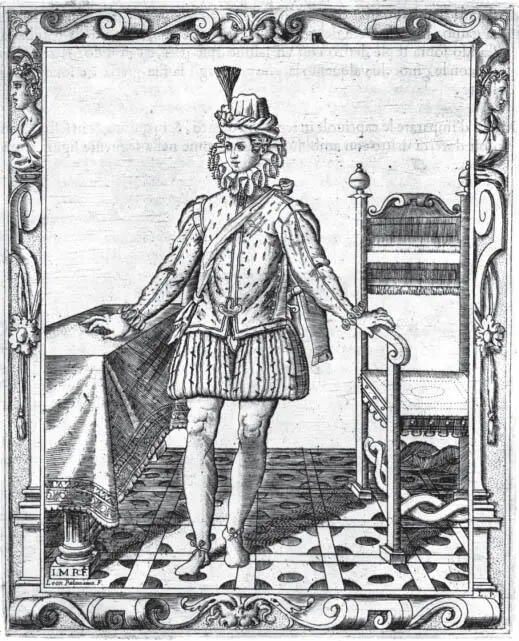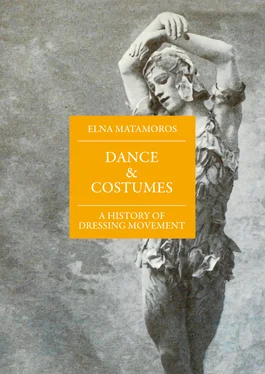Negri’s advice is a clear antecedent of the dancers’ subsequent barre work, in which the dancers lean on a wooden bar attached to the wall to practice some movements while keeping their balance. This incipient barre work is depicted in his book by a male figure that stands on one foot while holding a chair with his left hand and a table with his right hand; 17his clothing does not differ at all from the traditional court outfit of those days, and it is difficult to imagine that any movement can be performed gracefully wearing a ruff, a heavy jacket, etc.

2.2 - Nuove inventioni di balli… , by Cesare Negri, “Regola XXXVIII,” 1604.
Even if we can see a small and outlined waist in the dancer from Negri’s treatise, it does not mean that he wore a garment adjusted to the body: on the contrary, it was the chest that was covered by a stuffed jacket that increased its volume and made movement quite difficult. This particular jacket does not reach the knee, as in some cases, although it did cover the inner shirt, and it was probably the most important male garment of the time. Obviously, the courtiers wouldn’t dance without it; with a central slight opening that allows him to show part of his codpiece, and tight at the waist, so that the dancer could separate the thighs with relative comfort, facilitating and propitiating the incipient battements tendus –movement of a leg extending from the hip and showing the foot– or battements jetés –similar to battement tendu , but slightly raised from the floor– in their dance. The same filling that prevented the wrinkles in the doublet was also used in his trunk-hose (stuffed breeches), increasing the volume of the superior part of the legs, and consequently, making their crossing more difficult. The position that we find so frequent in images of the period, in which men usually keep their legs apart and one foot slightly forward, is suspiciously similar to the placement of Negri’s dancer. We dare to suggest that this pose would be a more comfortable position for the lower extremities in that costume, and probably this ‘discomfort’ was the reason of the battement tendu .
In the case of the dancer depicted in Le Gratie d’Amore , his jacket would be attached to the breeches by means of cords that passed through eyelets. His breeches would have been sewn –or at least fastened with suspenders– to stockings –knitted at that time– so that his movement would be very restricted in leg elevation and torso inclinations. The arm movements, limited by a jacket fitted tightly in the sleeves at the forearm, although wide at the shoulder, were so tight in the armhole that it was impossible to raise the arms without the jerkin pulling up from the breeches and stockings, so the dancer probably could not elevate his arms much more than shoulder height. Moreover, the position of his head would be very limited by the pleated ruff around his neck; although this ornament began to be used in the 16 thcentury as a gathering of fabric that was made by pulling the top cord of the edge of the shirt, it later became an obvious sign of aristocratic privileges as it grew in size: who wore the ruff did not need to work. 18How could they then pretend to dance while wearing this? There is no doubt that dance masters had to find a balance between putting their art at the service of the court to dignify it, and the difficulty –if not the total incapacity– that their dancers had to deal with. If they also refused to take off their hats, as happens to the dancer pictured in Negri’s treatise, any head movement would be even more uncomfortable. To make further movement even more difficult, our dancer wears a band crossing his chest, most probably with a symbolic meaning, perhaps in another attempt to add an aristocratic touch to his figure.
The footwear would take almost the entire 17 thcentury to develop to a higher heel and a more curved arch 19and had a design that could almost be described as ergonomic compared with the rest of the costume. Practically the only lack of functionality in favour of appearance is found in the ornaments around the ankle of the dancer, which at the same time prevented comfortable flexing and extensions of the foot. These shoes would probably be made with very fine leather that made a rounded cut in the front part of the shoe possible: it was an easy-to-handle material that would now facilitate an incipient raising of the dancer to the demi-pointe and a comfortable feeling while performing weight transitions in the choreography.
After carefully observing the dancer depicted in Negri’s treatise, it is not surprising how the official professionalisation of dance must have provided a certain relief for teachers and choreographers. However, the arrival of professional dancers to the stage did not prevent them from continuing to wear costumes similar to civil clothing. There was a reason for this: most dances were performed in the intervals of the plays and as part of other theatrical productions. Dance still would take some time to become a totally independent performing art. Over time, it was essential to create an audience interested in what had once only been offered in the courts, and these performances were now being made available at independent premises. These were places where people (the audience) could only participate by means of paying a ticket, which formed an indispensable element to the professionalisation of the performer. 20
Professional dancers officially went on stage in 1681, but the truth is that artists such as Mlle De Mollier, Mlle Girault, Mlle De la Faveur and other ladies held prominent positions in the incipient world of dance companies before that year; 21for example, Mademoiselle Vertpré had come to dance with Louis XIV himself in the Ballet de l’Impatience in 1661. 22The contact between the aristocratic dancers and professional dancers increased in those years; Molière took on a dancer of important lineage in his company, the Marquise Thérèse Du Parc; 23about her dancing we know that she had a quite virtuosic jump, and that she succeeded partially because of the movements of her dress. 24
In 1661, the lack of qualified personnel would lead to Molière creating, with Les Fâcheux , 25a new genre: the comédie-ballet . With this new work, the beautiful body of a nymph would dazzle Louis XIV himself. 26However, the great evolution of the dance technique would still take further decades to become a reality. This was the work of two women who competed in agility and vivacity on stage, and of whose images and notable written references are preserved: Marie-Anne de Camargo and Marie Sallé.
La Camargo 27(1710-1770) –as Marie Anne de Cupis used to be called because of her mother’s Spanish surname– had studied with Françoise Prévost (1680-1741), at that time Premiere Danseuse of the Paris Opera. Her great triumph took place when, in 1726, she crushed the masculine hegemony of the entrechats . Prévost, jealous of her student’s successes, refused to continue teaching her, so the young Camargo had to turn to other maestros –male teachers, especially Nicolas Blondy– to continue her training. 28From them she learnt the technique of the battus or entrechats . In fact, she will always be remembered as the first woman capable of performing an entrechat-quatre ; this jump of four criss-crosses of feet while in the air, was one of the first of a whole ‘family’ of jumps that was increasing in popularity in the following years. Due to the improvements in ballet training, dancers could successfully add more and more crosses of their calves in the entrechats through the years. In the 20 thcentury, the entrechat-dix (ten crosses) was first performed by Vaslav Nijinsky (1890-1950) 29who became famous, precisely, for his extraordinary jump and elevation. But of course, Nijinksy would wear what are considered to be the first male ‘tights’ in history, something that would undoubtedly make his job easier. 30Returning to La Camargo, dance historian Ivor Guest affirmed that what she performed was an entrechat-six ; 31that is, two more crosses than the entrechat-quatre , which would make La Camargo’s performance an extraordinary milestone for era.
Читать дальше













